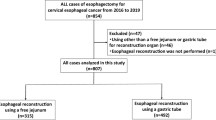Abstract
Background
There is no generally accepted treatment strategy for cervical cancer. The aim of this study was to evaluate the safety and efficacy of larynx-preserving limited resection with free jejunal graft for cervical esophageal cancer.
Methods
We retrospectively reviewed data of 58 patients with cervical esophageal cancer who underwent limited resection and free jejunal graft with or without laryngeal preservation. Among them, 45 patients received neoadjuvant treatment.
Results
Larynx-preserving surgery was conducted in 33 of the 58 patients (56.9 %). A higher proportion of patients who underwent laryngopharyngectomy with cervical esophagectomy (larynx-nonpreserving group) had cT4 tumors than those who underwent larynx-preserving cervical esophagectomy (larynx-preserving group) (72 vs. 12 %). The overall incidence of postoperative complications was similar in the two groups (56 vs. 52 %). The 5-year survival rate was 44.9 % for the entire group. Laryngeal preservation did not reduce overall survival compared with the larynx-nonpreserving operation (5-year survival rate: 57.8 vs. 25.8 %). Multivariate analysis identified the number of metastatic lymph nodes as the only independent prognostic factor.
Conclusions
The present study demonstrated that larynx-preserving limited resection with free jejunal graft is feasible. Also, this approach did not worsen the prognosis compared with the larynx-nonpreserving operation. Limited resection with free jejunal graft and laryngeal preservation is a promising treatment strategy for cervical esophageal cancer.

Similar content being viewed by others
References
The Japan Esophageal Society (2011) Comprehensive registry of esophageal cancer in Japan, 2003. Esophagus 8:9–29
Yin WB, Zhang L, Miao Y et al (1983) The results of high-energy electron therapy in carcinoma of the esophagus compared with telecobalt therapy. Clin Radiol 34:393–406
Ott K, Lordick F, Molls M et al (2009) Limited resection and free jejunal graft interposition for squamous cell carcinoma of the cervical oesophagus. Br J Surg 96:258–266
Triboulet JP, Mariette C, Chevalier D et al (2001) Surgical management of carcinoma of the hypopharynx and cervical esophagus. Arch Surg 136:1164–1170
Tong DK, Law S, Kwong DL et al (2011) Current management of cervical esophageal cancer. World J Surg 35:600–607. doi:10.1007/s00268-010-0876-7
Wang S, Liao Z, Chen Y et al (2006) Esophageal cancer located at the neck and upper thorax treated with concurrent chemoradiation: a single-institution experience. J Thorac Oncol 1:252–259
NCCN (2011) National comprehensive cancer network clinical practice guidelines in oncology. National Comprehensive Cancer Network, Fort Washington
Uno T, Isobe K, Kawakami H et al (2007) Concurrent chemoradiation for patients with squamous cell carcinoma of the cervical esophagus. Dis Esophagus 20:12–18
Bidoli P, Bajetta E, Stani SC et al (2002) Ten-year survival with chemotherapy and radiotherapy in patients with squamous cell carcinoma of the esophagus. Cancer 94:352–361
Stuschke M, Stahl M, Wilke H et al (1999) Induction chemotherapy followed by concurrent chemotherapy and high-dose radiotherapy for locally advanced squamous cell carcinoma of the cervical esophagus. Oncology 57:99–105
Chou SH, Li HP, Lee JY et al (2010) Radical resection or chemoradiotherapy for cervical esophageal cancer? World J Surg 34:1832–1839. doi:10.1007/s00268-010-0595-0
Ferahkose Z, Bedirli A, Kerem M et al (2008) Comparison of free jejunal graft with gastric pull-up reconstruction after resection hypopharyngeal and cervical esophageal carcinoma. Dis Esophagus 21:340–345
Daiko H, Hayashi R, Saikawa M et al (2007) Surgical management of carcinoma of the cervical esophagus. J Surg Oncol 96:166–172
Kadota H, Sakuraba M, Kimata Y et al (2009) Larynx-preserving esophagectomy and jejunal transfer for cervical esophageal carcinoma. Laryngoscope 119:1274–1280
Sobin LH, Wittekind C (2002) TNM classification of malignant tumours, 6th edn. Wiley, New York
Miyata H, Yamasaki M, Takiguchi S et al (2010) Prognostic value of endoscopic biopsy findings after induction chemoradiotherapy with and without surgery for esophageal cancer. Ann Surg 253:279–284
Makino T, Miyata H, Yamasaki M et al (2010) Utility of response evaluation to neoadjuvant chemotherapy by (18)F-fluorodeoxyglucose-positron emission tomography in locally advanced esophageal squamous cell carcinoma. Surgery 148:908–918
Bergquist H, Ejenell H, Fogdestam I et al (2004) Functional long-term outcome of a free jejunal transplant reconstruction following chemoradiotherapy and radical resection for hypopharyngeal and proximal oesophageal carcinoma. Dig Surg 21:426–431
Shirakawa Y, Naomoto Y, Noma K et al (2004) Free jejunal graft for hypopharyngeal and esophageal reconstruction. Langenbecks Arch Surg 389:387–390
Wang LS, Chu PY, Kuo KT et al (2006) A reappraisal of surgical management for squamous cell carcinoma in the pharyngoesophageal junction. J Clin Oncol 93:468–476
Jones AS, Roland NJ, Hamilton J et al (1992) Malignant tumors of the cervical esophagus. Clin Otolaryngol Allied Sci 21:49–53
Laterza E, Mosciaro O, Urso US et al (1994) Primary carcinoma of the hypopharynx and cervical esophagus: evolution of surgical therapy. Hepatogastroenterology 41:278–282
Kelly DJ, Wolf R, Shaha AR et al (1995) Impact of clinicopathologic parameters on patient survival in carcinoma of the cervical esophagus. Am J Surg 170:427–431
Kakegawa T, Yamana H, Ando N (1985) Analysis of surgical treatment for carcinoma situated in the cervical esophagus. Surgery 97:150–157
Conflict of interest
The authors declare no conflict of interest.
Author information
Authors and Affiliations
Corresponding author
Rights and permissions
About this article
Cite this article
Miyata, H., Yamasaki, M., Takahashi, T. et al. Larynx-Preserving Limited Resection and Free Jejunal Graft For Carcinoma of the Cervical Esophagus. World J Surg 37, 551–557 (2013). https://doi.org/10.1007/s00268-012-1875-7
Published:
Issue Date:
DOI: https://doi.org/10.1007/s00268-012-1875-7




